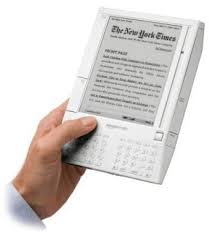
This is a guest post written by: Thomas Rheinecker
The Kindle is a new device that is changing the face of reading. No longer do you have to carry around every book you own to have the reliable information that they contain at your disposal. Research has been made easier with the rise of the internet, but finding reliable information can be difficult. You still do not always have access to the books that you need online so someone came up with an answer to this problem. That answer is the Kindle.
What Exactly Is The Kindle?
This is the place to start. Many people know what the Kindle is already, but many other have not even heard of it. Basically, the Kindle is an e-book reader. It allows you to download e-books and to read those books right on your Kindle.
It is not just another basic computer screen, however. It has what is called e-ink. While this new e-word may not have much meaning at first, it will once you understand what it means. E-ink refers to the fact that the display seeks to simulate the appearance of genuine printed material. It can be read in circumstances with low light. It also has a great battery life which is always a concern with any electronic device that you are likely to use for extended periods of time. Because it will allow you to read books, you will want it to last long enough for you to put in as much time reading as you wish.
The text is posted on the Kindle screen and is maintained in a static state. While other screens of this sort, such as television or computer screens, have their images refreshed on a regular basis the Kindle screen just maintains this image. This makes it much easier on the eyes.
7 Ways To Use It In The Medical Profession
1. You can download and read reference materials that you have read previously to refresh your memory. It could not get any easier with the Kindle.The 7 ways that every medical professional can use the Kindle are really transferrable to anyone who reads books or who works with any written resources. The potential for this tool is just beginning to be explored and will surely come out in time. Medical professionals never need to worry about not having the right resource book available again and everyone can feel good about that.
2. You can seek out new textbooks to look for answers too. Seeking out symptoms, conditions, and other relevant information is easy.
3. You can view photos on the Kindle if you need to see pictures of various symptoms conditions.
4. Studying medical texts is possible right on the Kindle. You can highlight portions of texts and you can even make notes on the Kindle as you go along.
5. Further and sometimes faster research can be done on its built-in web browser.
6. Multiple books can be read at once so when doing research there is no need to carry around all the books you need when all are present on the one Kindle.
7. You can listen to music while you read. This is an attractive feature for those who do not enjoy reading for extended periods in complete silence.
Thomas Rheinecker is a freelance author and writes about medical career topics, such as how to choose an online ultrasound school, tips for job advancement, and more.

No comments:
Post a Comment